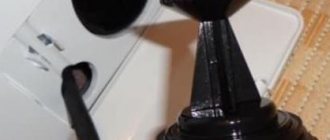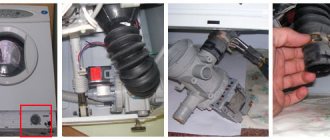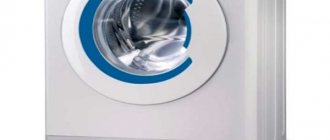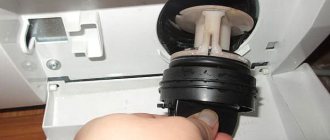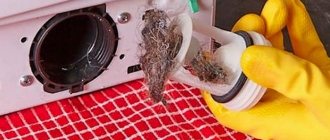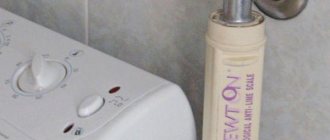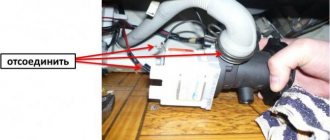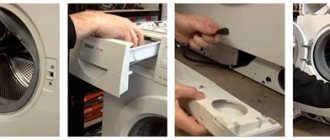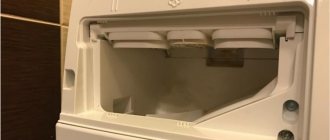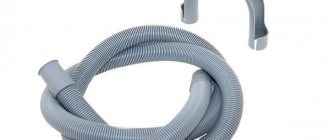Modern household appliances are reliable and highly functional. In order for it to serve for a long time and effectively, it requires appropriate care.
For a Bosch washing machine, these requirements include the need to regularly clean the drain filter.
We'll tell you how to clean the filter in a Bosch washing machine in this article.
How to clean a Bosch washing machine filter
Complex household appliances, which include washing machines, require preventive maintenance. Otherwise, active use of the unit will cause its rapid breakdown. One of the ongoing maintenance options is to clean the filter element to keep the sump pump functioning properly. The filter point is a barrier that protects the pumping unit from foreign debris that gets into the drum along with lint and hair. The resulting blockage complicates draining the liquid from the washing machine and causes the pump to fail. Let's try to figure out how to clean the filter in a Bosch washing machine.
Possible problems and solutions
Cleaning the filter involves partial disassembly of a rather complex unit. It is quite natural that in some cases, after carrying out the described procedures, various kinds of problems may arise. In most cases, they are associated with water seepage or leakage.
Main causes of problems:
Uneven or insufficiently tight placement of the part in the drain compartment.
When placing the element, it is important to avoid shifts and also monitor the tightening force. But you shouldn’t use too much force, as the plastic threads can easily break off, which will lead to constant leaks.- Gasket failure. It is the gasket that creates the necessary conditions for isolating the system from the external environment. But under the influence of time, this component can wear out and lose its properties. As a result, leaks occur. You can get rid of this kind of defect by replacing the gasket.
- Filter failure. Excessive cleaning and screwing force may result in component failure. In this case, the contact between the walls becomes less dense, which creates the necessary conditions for the passage of water. This problem can be solved by replacing the cleaning unit.
Where is the filter located?
By looking at the front panel of the Bosch washing machine, you can determine the location of the filter through which the liquid is drained. In the first Bosch machines, the filter was not covered with a lid and protruded outward. Today, in different Bosch models, the drain filter can be installed:
- maxx 4, maxx 5, maxx 6 – the drain point is located at the bottom, and the mesh of the water intake hose is located at the point where it is connected to the unit body;
- behind a rectangular cover at the bottom right, which is easy to find on the front panel. It is easily picked up by any sharp object;
- sometimes the drain filter of a Bosch washing machine is hidden behind a round hatch (location is the same as in the previous version), which opens with light pressure;
- there are options in which the filter is covered with a narrow panel located at the bottom of the MCA and secured with three latches that open alternately;
- classic 5 – a model with a frontal option for storing laundry. The filter point is located at the bottom left, hidden behind a round or rectangular lid, and is removed in the same way as in cases with devices that feature vertical loading.
How to clean the drain filter
Having found the location of the part, we begin cleaning. To begin with, the washing machine must be disconnected from the electrical network and the central water supply, tilted back so that it becomes possible to place a container for dirty liquid, which will begin to pour out of the filter.
The algorithm of actions is as follows:
- a basin is installed;
- the lid opens, hiding the part we need;
- On the right is the filter itself, on the left is a short sleeve through which the liquid is drained. It should be pulled out, the plug removed, and the water drained;
- Now it’s time to dismantle the filter element. The plug is unscrewed in the direction opposite to the movement of the clock hand. In this case, several revolutions are performed;
- the remaining liquid is drained, you inspect the niche from the inside, check the filter element, clean and rinse it;
- wipe the landing niche with a rag;
- the part is installed in its place, screwed until it stops;
- close the hatch, remove the basin, return the Bosch washing machine to its original position.
Signs of blockages
You can identify the presence of a blockage in the drain filter by the following signs:
- The machine does not turn on and gives an error. The error code can be anything, but it is important to make sure that the device is correctly connected to the water supply and electrical network, and that the drain hose is located at the correct angle;
- the time for draining water increases due to its prolonged removal from the drum or at the end of the cycle the laundry remains wet, and a small amount of liquid is present inside the tank;
- The “Spin” or “Rinse” functions do not work.
Seeing signs on your device?
Not really
What to do if it is impossible to unscrew the filter?
Most often, this element is removed without much difficulty. However, there have been cases in which the filter was not removed, as if it was firmly stuck, and you will have to use special tools to remove it.
Now we proceed in the following sequence:
- we place the snail removed from the Bosch washing machine with the fitting facing the ceiling;
- move the pump all the way in a clockwise direction;
- the stopper in the form of a mustache must be squeezed out;
- turn the pump again in the direction of the arrow to pull it out;
- access to the insides of the cochlea has opened, which must be cleaned and the block assembled in the reverse order.
How to remove and clean the filter in a Bosch washing machine?
Bosch is home appliances produced in Germany for several decades. Many household appliances produced under a well-known brand have proven themselves to be high-quality and reliable. Washing machines were no exception.
But during operation, even high-quality equipment can break down: the machine does not drain or fill with water, and an error code is displayed on the panel. Often such malfunctions in the operation of a Bosch machine occur due to a clogged filter.
Maintenance period and signs of clogging
Bosh brand washing machines are high quality and reliable. However, sometimes situations may arise when draining is difficult or an error code is displayed on the electronic display, indicating that the filter element is clogged.
Sometimes contamination leads to a sharp decrease in the quality of the spin cycle. If you wash down products, it is recommended that you carry out a cleaning procedure after each wash.
In this case, it becomes necessary to perform a filter cleaning procedure. After this, the machine’s performance will be restored.
The service life depends on how efficiently the washing machine is used. If there is little laundry and it is used no more than once a week, then three months may pass between filter cleanings. But when there is a lot of laundry or the washing machine is required almost daily, it is advisable to clean the filter element at least once a month.
How to get a filter?
Bosch washing machines have 2 types of filters.
- The first is located at the junction of the machine with the water supply hose. It is a metal mesh that protects the motor from possible impurities coming from the water supply. It could be silt, sand, rust.
- The second is located under the front panel of the washing machine. Water is drained through this filter during the washing and rinsing process. It contains objects that can come off your clothes or fall out of your pockets.
In order to remove the filtration mesh installed at the water supply point to the machine, simply unscrew the water hose. The filter mesh can be easily removed by picking it up with tweezers.
The second filter is hidden under the front panel. And in order to clean it, you will need to remove it.
Depending on the model, this hole may be hidden under a specially designated hatch or false panel.
For top-loading machines, the drain hole may be located on the side panel.
The drain filter hatch is a dedicated panel located in the lower right corner of all Bosch machine models. It can be either square or round in shape.
The false panel is a narrow strip located at the bottom of the front panel. You can remove this cover by sliding it off the hooks. To do this, the panel needs to be lifted up.
In order to remove the required part, you need to remove the panel from the latches by pressing on its upper part. Then you need to unscrew the filter itself, for which you need to turn it counterclockwise 2-3 times.
If the part is difficult to unscrew, you need to wrap it with thick fabric. This way your fingers will not slip off the part, and you can easily remove it.
Folk remedies for caring for the unit
Let's look at the main products used to clean the drain filter and how to use them. These are proven effective methods that you can use to prevent and clean filters using simple DIY methods.
Application of citric acid
Citric acid is an affordable and cheap product that is odorless.
You should not overuse citric acid or use it at high temperatures, as it can damage plastic elements.
Rules for using lemon:
- Pour 60-100 grams of acid into the powder container. The amount of product is determined by the length of time during which no cleaning was carried out.
- Turn on the device for a full cycle at a temperature of 60 degrees or more. The maximum temperature mode is chosen if the machine is heavily dirty.
- Remove dirt and acid residues by rinsing. If the machine is not completely cleaned, repeat the procedure.
Upon completion, the filter is cleaned of any remaining deposits.
The process of cleaning a washing machine using citric acid is demonstrated in the video:
Cleaning the filter with soda
Baking soda is an affordable solution for cleaning mold. Soda is used to clean all parts on which it forms.
Mode of application:
- Soda is diluted one to one with water.
- The fabric is moistened in a solution of water and soda.
- Use a soaked cloth to wipe moldy elements.
- After several hours, the wash is started.
- At the end of it, remove any remaining dirt manually.
The procedure can be repeated several times, depending on the degree of contamination.
Using table vinegar
When using it, not only mold and scale are removed, but also an unpleasant odor.
Mode of application:
- 200 ml of 9% vinegar is poured into the powder tray.
- Turn on washing at temperatures from 60 to 90 degrees.
- After filling the machine with hot water, pause for 1 hour.
- Continue washing until complete.
- Clean the filter from remaining contaminants.
Then wipe all surfaces with a clean, dry cloth and allow to dry.
The video demonstrates cleaning technology using vinegar:
Whiteness in the fight for purity
The product can be classified as both professional and home use. Simple and affordable, it has a pungent odor. Provides high-quality cleaning of the drain filter.
Method of use:
- White is poured into the container for filling the powder.
- Turn on the longest cycle with the highest temperature for 15–20 minutes, pause the machine and leave for 2 hours.
- Includes washing and rinsing.
- Start the rinse cycle again.
Finally, wipe the parts dry with a rag.
Use of copper sulfate
This is an excellent, easy to use, affordable, odorless product.
Copper sulfate is an absolutely harmless anti-fungal remedy for machine parts. It can be purchased at a hardware store or market for summer residents
Instructions for use:
- The powdered substance (30 g) is diluted in 1 liter of water.
- Wipe all the insides of the car and leave it for a day.
- Start the wash with any washing powder.
As in other cases, turn on the additional rinsing program, and after cleaning, wipe with a dry cloth.
If you don’t want to do the “dirty” work yourself, you can call a plumber. Professional cleaning will eliminate the need to do work that is unusual for you.
Cleaning steps
Before removing the drain filter, it is necessary to prepare a flat container and floor rags, since water may accumulate at the location of the filter. Next you need to perform the following manipulations:
- turn off the power to the household appliance;
- spread the rags on the floor and prepare a container for draining the water;
- open the panel and unscrew the required part;
- clean the filter from dirt and foreign objects;
- Carefully clean the hole in the machine where the filter will be installed later;
- install the filter in its place;
- close the panel.
Process
Cleaning the washing machine drain pump filter
Before removing the drain filter, be sure to drain all the water from the machine and disconnect it from the power supply.
After removing the lid, you need to place a container under the tank for the water that will flow out of it. Then you need to turn the outer part of the filter counterclockwise until it is completely pulled out. To get rid of hair, lint and threads, use a paper towel. The filter itself now needs to be placed in a container of hot water and left for 10 minutes. During this time, the residues that could not be cleaned with a towel fell away under the influence of hot water.
Now you need to wipe all the insides of the drum, including under the sealing lip of the hatch, so as not to immediately clog the just cleaned filter with the lint that has accumulated there.
When you have completely cleaned the filter, you need to screw it back into the washing machine. If you removed the hose, be sure to put it back in place before you start screwing in the filter.
If the filter was under the drum, then you need to put it in place and secure the cover. After this, you need to put the drum back on the filter, and then fasten the nut and the drum cover.
After cleaning all the filters and installing them in their original places, it is better to run the machine without clothes to check the operation of the pumps. If leaks occur, you can conclude that the filter is damaged or improperly installed. In this case, you need to drain the water from the tank and try to install the filter again.
Input filter. Usually this filter is located in one place in all washing machines - on the back wall. To clean it, you need to move the machine away from the wall and unscrew the fastening of the water supply hose. After disconnecting the hose, you will notice a small protrusion at the entrance to the machine. This is what we need.
Cleaning the washing machine inlet filter
To clean the inlet filter from dirt and foreign objects, carefully pull it out. This is best done with pliers.
This fragile part must be pulled out very carefully, without tugging, otherwise you will have to replace it (it cannot be repaired). Rinse the filter mesh under the pressure of warm water, and then clean it of plaque and dirt using an old toothbrush.
If after such cleaning the mesh is not transparent, then you need to change it or try to first soak it in an anti-scale solution and then clean it again.
How to choose a product?
Hard water, detergents, long-term use - all this can affect the drain filter, and it can be difficult to wash it with ordinary water.
But you shouldn’t use abrasive cleaners or chlorine- or acid-based compounds for cleaning. Thus, the material from which spare parts for Bosch household appliances are made can be damaged by aggressive substances.
Therefore, you can use a soap solution or dishwashing detergent for cleaning. A special detergent for washing machines may also be an excellent option
When cleaning, do not use hard meshes or sponges - only soft cloth.
So, by following simple recommendations, you can clean the drain hole yourself, without calling a specialist and saving money on the family budget.
And to avoid breakdowns of the washing machine in the future, you need to regularly clean the drain hole. It is also necessary to ensure that foreign objects do not fall into the washing machine drum.
You can find out how to clean the filter of your Bosch washing machine below.
Operating rules
Regular filter cleaning will extend the life of the machine and improve the quality of its operation. However, it is equally important to ensure cleanliness when washing.
To do this, it is recommended to pay attention to the following:
- Before you start washing, you need to check the contents of the pockets and make sure that there are no foreign objects there.
- If you need to wash clothes with beads or other parts that can come off, it is recommended to put them in a cloth bag.
- You need to check that there are no clothes with poorly sewn buttons.
By reducing the risk of contamination, the owner takes care of the health of his washing machine and helps to increase its service life.
How to clean the filter in a Bosch washing machine
The instructions for the washing machine require the user to clean the garbage filter from time to time, but how to clean the filter in a Bosch washing machine? This procedure is simple, but has nuances that can confuse a novice user. We decided to provide step-by-step instructions that will tell you in detail: where to find the garbage filter, how to remove and clean it, and how to put it back in place. If you have recently been using an automatic washing machine from Bosch, this article will be useful to you.
Checking the functionality of household appliances
After cleaning the drain filter has been carried out, you need to ensure the quality of the work performed. To do this, the Bosch machine is connected to communications and the wash cycle is started. When starting up for the first time after cleaning the filter, you must be near the operating device to monitor its operation.
After cleaning, if the part was not put back into place carefully, water may leak from the unit. To solve the problem, the panel behind which the filter is located must be removed and the assembly checked for correct and reliable installation. If cracks or other damage to the filter plastic are found, the part will have to be replaced.
If cleaning the filter was carried out as part of the fight against a problematic drain, then the cleaning work performed is not always able to solve the problem. In the event that the drainage does not improve, it will be necessary to use alternative methods to resolve the issue .
Filter location
If you look closely at the front of the Bosch washing machine, you will immediately determine where the drain filter is located. In the vast majority of cases, it is located in the front, in the lower right corner of the machine body. In older models of Bosch washing machines, the filter was not hidden by a lid and stuck out; now the lid is present in all cases. Depending on the front-loading Bosch machine model, the filter may be located:
- behind the rectangular hatch in the lower right corner of the body on the front wall of the machine, the hatch cover can be picked up with a fingernail, after which it can be easily opened;
- behind the round hatch in the lower right corner of the machine body on the front wall, the hatch can be opened by lightly pressing on it;
- Behind the narrow bottom panel, which is located under the front wall of the machine body, the panel is secured with three plastic latches. They need to be clicked off one by one.
Front-loading models also have a drain filter. It is located in the front of the machine body in the lower left corner. They hide behind a round or square door and are removed just like front-loading machine filters.
Some rare models of Bosch washing machines produced before 2005 do not have garbage filters at all. They simply weren't included in the design. On such machines, the volute may become clogged and to clean it you will have to remove the lower decorative panel, remove the pan and unhook the pipe. There is another way to gain access to a snail clogged with dirt, but it is difficult.
If you have difficulty unscrewing
One of the most common problems associated with cleaning the washing machine filter is the inability to remove it from the unit body.
This part can be difficult to unscrew or it gets stuck in the hole and is not completely removed.
This problem occurs especially often when there is a long-term lack of preventive care or when a foreign object from clothing gets into the pump.
The reasons for the impossibility of removing the filter from the connector may include the following circumstances:
- a foreign object has blocked the rotation of the part. Such a foreign body can be a deposited piece of bra bone or a large button;
- A large amount of scale has formed on the part, which does not allow it to be removed from the hole.
To solve this problem, you must adhere to the following algorithm of actions:
- use pliers. The auxiliary tool should be used carefully so as not to damage the plastic parts. Using pliers, grab the filter handle and try to turn it. This tool can be replaced by a small piece of dry cloth, which will make the grip stronger;
- remove the pump and clean the filter through it. This unit, depending on the model, is located behind the rear or front wall of the case. To access it, you will need to disconnect the wiring and clamps of the drain pipe, pull out the hose going to the pump volute, and remove the pump itself. It is possible to remove dirt from the filter through the holes for the drain pipe. After this, the mesh should be easily removed from the housing using standard methods. Reassembly of the dismantled unit is carried out sequentially in the reverse order.
If you have difficulty removing a part, do not use force or pick out the hole with a screwdriver or other objects. The best choice in this situation is to call a washing machine repairman to your home. If the thread of the snail is damaged, replacing this element will cost much more.
You can also read on our website how to clean an elastic band in a washing machine.
Cleaning
Well, the garbage filter has been safely found, you can start cleaning. First, we tilt the washing machine a little back so that under the body in front we can place a flat container for the sewage that will flow out of the filter snail.
- We substitute a small basin.
- Open the lid that hides the filter.
- On the right we see the filter itself, on the left there is a short hose for draining water. We pull out the hose a few centimeters and, having pulled out the plug from it, drain the dirty water into a basin.
- Now you can remove the filter. We need to unscrew the plug by turning it counterclockwise a few turns.
- The remaining water will pour into the basin through the hole formed, and you should inspect the internal surfaces of the niche and the filter itself for dirt and foreign small things that accidentally got there.
- Wipe the filter and seat with a cloth.
- We insert the filter back into the niche and screw it fully clockwise.
- Close the hatch, take out the basin and place the machine in a stable position.
What if the filter doesn't come off?
On most models of Bosch washing machines, the filter can be removed without any problems. But there are times when the filter does not want to be removed, it seems that it is tightly stuck and can only be removed with the help of a heavy tool.
It’s not worth breaking the machine by picking the filter from the front. If it does not unscrew, we will try to remove the “capricious” part by partially disassembling the Bosch washing machine, namely by removing its front wall. By removing the front wall of the housing, we gain access to the drain block: two pipes, the base of the drain hose, a pump and a volute, in which the “capricious” garbage filter is placed. We need to first turn off the power to the washing machine, loosen the clamps on the pipes, remove the pipes and remove the snail along with the filter and pump. Next we proceed like this.
- We turn the removed snail with the fitting up.
- Move the pump clockwise until it stops.
- Squeeze out the locking tab.
- Turn the pump clockwise again and remove it.
- Having gained access to the internal cavity of the cochlea, we clean it and put the block back together.
In this case, we were able to clean the filter without removing the part itself. In order not to disassemble the machine for repeated cleaning in the future, soak the snail together with the filter in a lubricant like WD-40. The filter thread will oxidize, and it will unscrew easily and naturally.
Step-by-step instruction
Unscrewing a soured washing machine filter is sometimes very difficult.
It is necessary to act carefully, not to apply too much force, so as not to break the machine parts.
In addition, you need to make sure that the rotation is in the right direction - counterclockwise. To resolve the issue, you can use several methods.
Using a tool
One of the easiest options is to try to grab the filter handle with pliers and unscrew it
Caution is required here as the force is quite large.
Without proper calculation, you can break the handle of the knot. You need to act slowly, rocking, turning the plug in both directions and gradually increasing the amplitude.
If the filter can be turned a quarter turn but does not go any further, do not apply force. It's better to try another way.
Removing the drain pump
If you cannot unscrew the cover using the usual method, you can try dismantling the entire pump. As a rule, it is attached to the machine body with two screws, but there are a lot of manufacturers, so any options are possible.
Getting to the node from the other side is much more difficult. Partial disassembly of the machine body will be required. In order to determine the location of the device, you need to look inside the case.
The easiest way is to tilt the car and look from the bottom. Sometimes it is not there at all, or it can be easily removed. Then you can support the housing on a wall or other strong object and disassemble the pump from below.
Another option is to turn the car around, remove the back wall and disassemble the pump from the back. This method is somewhat worse, as you will have to reach for the part through the entire thickness of the machine, which is filled with other parts.
However, the issue is completely solvable. The main thing is to acquire the necessary tools and ensure maximum ease of work.
The insides of the machine should be well illuminated, act carefully, trying not to damage the plastic tank of the machine.
Deflection of the machine and tapping on the filter unit
One effective way is to carefully rest the machine on the wall at an angle of approximately 45° and tap the filter with something soft.
The easiest way is to use your own fist. Shock may cause debris and particulates to fall off the filter cover. After this procedure, it is often possible to unscrew the filter without much difficulty.
Sometimes things don't work out the first time. You can try repeating the procedure several times if any positive changes are noticeable.
The main thing is not to overdo it and not to drive the lid in even harder. Then the only option left is to completely break out the problem unit and replace it with a new one.
Breaking out
Sometimes situations arise when no methods help. For example, the filter cover broke immediately (or during previous attempts), or when unscrewing, parts of the housing, pipes and other elements were damaged.
If such situations arise, all that remains is to resort to the last, most drastic method - break out the filter in order to get rid of the defective unit and replace it with a new one.
To perform the work, the machine is placed on its side and work begins from the bottom. Unscrew the mounting screws. If this cannot be done, they are drilled out or carefully cut off.
Some craftsmen destroy the plastic case from the inside and gradually break off pieces of plastic from it. After some time, the filter and pump can be disconnected from the machine body.
Immediately you need to unscrew and disconnect the pump - it is in order, it will still serve. Be careful with the terminals, they are fragile and can be damaged! The remains of the housing with screws are removed, the spring clamps are pressed out and the pipes are disconnected.
It is necessary to remember which of the rubber pipes leads where, since for an untrained person they are all the same.
ABOUT
Often it is possible to completely disconnect the filter with the pump, but the cover still does not unscrew.
In such situations, you can try to disconnect the filter from the pump, clean it from the inside and soak the housing in a basin or bucket.
Take warm water, dissolve liquid soap or washing powder in it and leave the body for several hours. Fatty deposits and dirt will become wet and fall away from the inner surface of the lid. Now you can try again to unscrew it in the usual way.
Replacing the snail
The washing machine pump (pump or “snail”) sooner or later fails. In addition, when removing a soured filter, it is easy to damage the pump, which will require replacing the entire assembly.
The procedure is simple if the old filter and pump are already disconnected and turned off. The main problem is to find suitable replacement elements.
Then all actions will consist of sequential installation of the filter and pump in their standard places in the machine body.
Why does a washing machine need a drain filter and why does it need to be cleaned?
For a Bosch washing machine, this unit is very important. It stands in the way of dirty water from the tank to the drain pump, which pumps it out. The filter prevents all kinds of debris from getting into the pump and causing it to fail. What kind of debris could be in the water? This is lint, wool and hair that is always found in dirty laundry. In addition, small objects can accidentally get into the tank, and buttons, rivets, rhinestones, etc. sometimes come off from clothing.
All debris accumulates in the drain filter. If it is not removed from there in time, a blockage will form. This causes serious problems:
- The water does not drain well, and over time the drain stops functioning altogether. In this case, the pump wears out and quickly fails.
- Some of the debris from the filter can get into the pump and simply break it (jam the impeller or damage its blades).
- Even if the clog does not reach such a scale as to harm the pump, it can cause an unpleasant odor from the washing machine. This smell is transferred to the laundry during washing.
How often should you clean your Bosch drain filter?
- As a rule, manufacturers recommend cleaning every 2-3 months.
- If you wash frequently, the filter may become clogged more quickly. Also, blockages quickly form when washing pile fabrics (flannel, warm knitwear) and when there is pet hair on clothes. In such cases, it is worth cleaning the filter monthly.
- It is advisable to clean the drain after each wash of products made from natural down (down jackets, pillows), artificial fur (toys, children's blankets), woolen blankets and heavily soiled items.
The need to clean the filter may also be indicated by problems with the operation of the washing machine:
- the machine began to drain water poorly or does not drain it at all, even forcibly;
- the drain seems to work, but the laundry doesn’t spin well; repeated spinning may work well, or it may be ineffective;
- washing stops abruptly in the middle of the cycle and does not resume;
- Rinse and/or spin programs do not start.
The most accurate recommendations on the frequency of cleaning the filter of a Bosch washing machine are in the instructions for it. The order of the procedure is also indicated there. But you can use our recommendations. We tried to describe everything in as much detail as possible.
Where is the Bosch washing machine drain filter located?
All washing machines have filters next to the drain pump. This is the place at the bottom of the case (regardless of the type of laundry loading - frontal or vertical), usually diagonally from the tray for adding powder. There you can see a small hatch or a small removable panel behind which the drain filter is hidden. Getting there is usually not difficult. But for each brand (and sometimes for individual models of washing machines), the design and location of the drain filter are slightly different.
Look in the summary table where the drain filter of your washing machine is located:
| Washing machine brand | Drain filter location | Photo |
| LG | Behind the hatch, on the left or right side of the hull | |
| Indesit, Ariston, Ardo, Hotpoint Ariston | On the right side of the case, behind the removable panel | |
| Candy | Behind the small hatch, on the left or right | |
| Bosch, Siemens, AEG | Behind the decorative strip (panel), on the right side of the case | |
| Samsung | In the lower right corner of the case, covered with a hatch or decorative panel | |
| Electrolux, Zanussi front loading | On the right side, behind the plastic hatch; for some models - on the back side of the case | |
| Electrolux, Zanussi top loading | In the drum of the washing machine, built into its edge (the filter should be removed from the inside) | |
| Whirlpool top loader (and many other washing machines of this type) | At the bottom of the case, on the left, behind the small hatch | |
| Atlant | On the right, at the bottom of the hull, behind a small hatch | |
| Some small-sized washing machines of different brands with a load of up to 3.5 kg | There is no drain filter |
Cleaning the Bosch drain filter step by step
- Step 1. Prepare a large rag that absorbs moisture well. If you can lift the washer, take a low, flat basin - into it you will pour the water that remains in the drain system. There will be little water (up to 0.5 l).
- Step 2: Unplug the washing machine.
- Step 3 : Turn off the water supply valve.
- Step 4. Having determined where the drain filter is located on your Bosch washing machine, open access to it. Remove the hatch (decorative panel). Pull it towards you, and if that doesn’t work, try moving it from right to left. The lid may be easy to open by hand, but sometimes the latches hold tightly. In this case, you will have to use a screwdriver or knife. Just be careful not to damage the fragile plastic! Lightly lift the lid and set it aside.
- Step 5. Place a rag on the floor under the filter or place a prepared container, lifting the body of the machine. Many washing machine models have a special emergency hose for draining remaining water. It is located near the drain filter and is closed with a plug. The hose must be removed from the fastener, opened and lowered into the container. When the water flows out, it must be closed and replaced. After draining this way, there will still be some water left in the filter, so do not remove the rag.
- Step 6: Remove the drain filter. To avoid flooding the floor, do it gradually - first unscrew the part a quarter turn and let the liquid drain. Next, unscrew the assembly completely and pull it out. Interestingly, some models of washing machines have a plug in front of the filter itself. It is unscrewed and the water is allowed to drain, and only then the filter is removed.
- Step 7: Thoroughly clean the removed filter. Remove any large debris from it, and then wipe off the residue with the abrasive side of a clean kitchen sponge. Rinse the part under the tap with clean warm (not hot!) water. There is no need to use detergents. Cleaning chemicals, like hot water, can damage the plastic and rubber seal of the filter.
- Step 8: Clean the filter hole and drain pump in your washing machine. Remove any remaining debris and wipe accessible surfaces with a damp sponge. Look inside the drain pump (it's better to shine a flashlight there). If debris or threads wound around the impeller are visible, they must be carefully removed. Also try how the pump impeller rotates. It should turn easily - if the blades get stuck, it may mean there is still a blockage in the pump. Try to remove it carefully yourself, and if that doesn't work, contact a Bosch repair specialist.
- Step 9: Reinstall the cleaned filter. Make sure it stands up straight and tight. When tightening the plug, do not overdo it so as not to strip the threads of the soft plastic.
- Step 10. Be sure to check how the machine works after cleaning. Turn it on, turn on the water and run a short rinse cycle. You need to make sure that there is no water leaking near the filter. If streams or even individual droplets begin to flow out around it, you will have to deal with this problem (read below how exactly).
- Step 11. After making sure that there are no leaks near the installed filter, close it with a decorative hatch (panel). Now the machine can be put in place, connected and used.
Possible problems when cleaning the filter of a Bosch washing machine
| What happened | Why did it happen | What to do |
| The filter is stuck and cannot be unscrewed, or has been unscrewed but cannot be removed. | The unit had not been cleaned for a long time, and the threads were “overgrown” with scale. Or a large object is stuck across it - a button, a hairpin, a coin, a dense accumulation of lint. | First, try unscrewing the part with pliers. They will give a little more effort. But do not overdo it so as not to break the plastic part. If pliers do not help, you will have to clean the filter through a pump. To do this, remove the housing wall, disconnect the wiring, then the drain hose fasteners and pull out the pump. Once cleaned through the hole, the filter should come out easily. But this cleaning method will already require certain knowledge about the design of the Bosch washing machine. It is better to entrust this work to a specialist. |
| After cleaning, the installed filter allows water to pass through and the machine flows. This can happen immediately (during a test wash) or after several work cycles. | The filter is not installed correctly - unevenly or loosely. | Disconnect the washing machine from the network and water supply again, remove any remaining water from the drain system. Then tighten the filter more tightly or remove it and install it straight. |
| Broken thread. | Screwing the filter plug in too tightly can damage the plastic threads. Replacing the filter itself or the filter together with the volute (the entire threaded pair) will help. In the latter case, it is better to invite a master. | |
| Damaged seal. The reason may be aging of the rubber (the gasket dries out and cracks), as well as careless cleaning (use of sharp objects, hot water). | The rubber sealing gasket must be replaced. Sometimes it is impossible to change only the seal; in such cases, the entire filter is replaced. |
Now you know how to clean the drain filter of a Bosch washing machine. But if you don’t have time to do this yourself or have problems during the process, contact the Repair Club. Our specialists will carry out the cleaning quickly and inexpensively, with a visit to any address in St. Petersburg.
Other reasons for slow drainage
A clog at the filter level is a common, but not the only reason for slow or non-existent drainage. Quite often it is caused by a malfunction of the pump (pump), problems with the pressure switch (water level sensor) or malfunctions of the control module. Sometimes it happens that water is drained on some programs, but not on others. In this case, the mechanical components of the device are working properly; the problem should be looked for in the electronics.
Drain pump failure
The pump is responsible for pumping dirty water from the tank through a system of pipes and hoses directly into the sewer. The pump is usually installed at the bottom of the machine, under the tank. This arrangement allows the device to optimally perform its function. Over time, the pump, like the drain filter, may become clogged, and then the water will drain very slowly. When metal objects (keys, coins, buttons) enter the drain system, they often break the impeller blades or damage the pump body. A complete lack of drainage most often indicates a violation of the integrity of the pump or combustion of the motor as a result of voltage surges.
Electronics malfunction
This breakdown is somewhat less common than the ones listed above. However, it is this that is the most difficult and expensive to eliminate. All processes in the machine are controlled by an electronic module; it is this module that activates the pump. At the right moment, a command is given to turn on the pump, and when all the liquid is pumped out of the tank, a signal to turn off is given. If the wiring or triac of the pump burns out, the connection between the nodes is interrupted, and water will not be drained, even if the pump is working.
Such repairs are not cheap, because the repairs are carried out by highly specialized electronics specialists. But they, as a rule, give a guarantee on their work for a month or two. After this period, the problem may return. In addition, it is not always possible to restore a damaged control unit, and replacing it is impractical due to the high cost of the spare part itself. Therefore, if you have such problems with electronics, you should seriously think about buying a new washing machine.
Problems with the water level sensor
A faulty pressure switch can also cause a lack of drainage and malfunctions in the washing machine. Thanks to this sensor, the electronics “see” whether there is now enough water in the tank to complete the wash. If the pressure switch measures the level incorrectly or does not receive signals from it at all, the program will freeze. It is better to replace a broken sensor, since washing its tube or cleaning the contacts usually helps for a short time, and the user again faces inconvenience.
How to clean a Bosch washing machine filter
Complex household appliances, which include washing machines, require preventive maintenance.
Otherwise, active use of the unit will cause its rapid breakdown. One of the ongoing maintenance options is to clean the filter element to keep the sump pump functioning properly. The filter point is a barrier that protects the pumping unit from foreign debris that gets into the drum along with lint and hair. The resulting blockage complicates draining the liquid from the washing machine and causes the pump to fail. Let's try to figure out how to clean the filter in a Bosch washing machine.
Prevention measures
Actions that will help increase the service life of the machine and reduce the frequency of cleaning the drain filter:
- use of high-quality washing powders intended for washing machines. Failure to use cleaning products containing phosphates will accelerate the appearance of lime deposits inside the appliance. This has a direct impact on the drain pump;
- active use of washing bags, which prevent small parts of clothing or the contents of pockets from getting into the drum. Their use is especially important when washing clothes with small buttons or various decorative elements;
- installation of a filter for the supplied water. This prevents the appearance of scale and the deposition of rust or other impurities on the parts of the unit due to poor-quality tap water;
- when the first signs of blockage appear, you should immediately disassemble the device and remove all accumulated debris;
- use of pre-soak in a basin for excessively soiled laundry. This operation is necessary to remove large pieces of dirt, such as lumps of earth;
- regular use of products for the prevention and removal of scale. One of the factors causing blockages is the accumulation of loose pieces of scale from the heating element in the trap. This problem can only be dealt with by regularly preventing deposits and descaling the washing machine;
- control over the complete drainage of water from the tank after the end of each wash cycle. The drum must be completely dry and the laundry must be well wrung out. Also, there should be no foreign unpleasant odor coming from the fabric.
By the way, on our website you can also read how to clean a washing machine completely.
Where is the filter located?
By looking at the front panel of the Bosch washing machine, you can determine the location of the filter through which the liquid is drained. In the first Bosch machines, the filter was not covered with a lid and protruded outward. Today, in different Bosch models, the drain filter can be installed:
- maxx 4, maxx 5, maxx 6 – the drain point is located at the bottom, and the mesh of the water intake hose is located at the point where it is connected to the unit body;
- behind a rectangular cover at the bottom right, which is easy to find on the front panel. It is easily picked up by any sharp object;
- sometimes the drain filter of a Bosch washing machine is hidden behind a round hatch (location is the same as in the previous version), which opens with light pressure;
- there are options in which the filter is covered with a narrow panel located at the bottom of the MCA and secured with three latches that open alternately;
- classic 5 – a model with a frontal option for storing laundry. The filter point is located at the bottom left, hidden behind a round or rectangular lid, and is removed in the same way as in cases with devices that feature vertical loading.
How to clean the drain filter
Having found the location of the part, we begin cleaning. To begin with, the washing machine must be disconnected from the electrical network and the central water supply, tilted back so that it becomes possible to place a container for dirty liquid, which will begin to pour out of the filter.
The algorithm of actions is as follows:
- a basin is installed;
- the lid opens, hiding the part we need;
- On the right is the filter itself, on the left is a short sleeve through which the liquid is drained. It should be pulled out, the plug removed, and the water drained;
- Now it’s time to dismantle the filter element. The plug is unscrewed in the direction opposite to the movement of the clock hand. In this case, several revolutions are performed;
- the remaining liquid is drained, you inspect the niche from the inside, check the filter element, clean and rinse it;
- wipe the landing niche with a rag;
- the part is installed in its place, screwed until it stops;
- close the hatch, remove the basin, return the Bosch washing machine to its original position.
What to do if it is impossible to unscrew the filter?
Most often, this element is removed without much difficulty. However, there have been cases in which the filter was not removed, as if it was firmly stuck, and you will have to use special tools to remove it.
Now we proceed in the following sequence:
- we place the snail removed from the Bosch washing machine with the fitting facing the ceiling;
- move the pump all the way in a clockwise direction;
- the stopper in the form of a mustache must be squeezed out;
- turn the pump again in the direction of the arrow to pull it out;
- access to the insides of the cochlea has opened, which must be cleaned and the block assembled in the reverse order.

